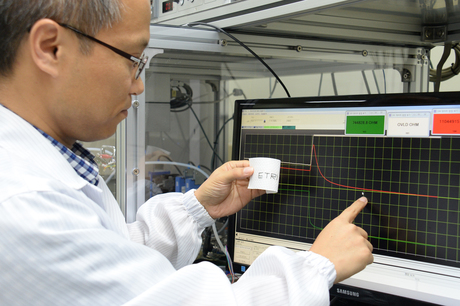'e-fabrics' detect toxic gases

Scientists in Korea have developed wearable, graphene-coated fabrics that can detect dangerous gases present in the air and alert the wearer by turning on an LED light.
Researchers from the Electronics and Telecommunications Research Institute and Konkuk University in the Republic of Korea coated cotton and polyester yarn with nanoglue called bovine serum albumin (BSA), which was then wrapped in graphene oxide sheets.
The new technology would allow outdoor wearers to receive information about air quality and could also be incorporated with air-purifying filters to act as ‘smart filters’ that can both detect and filter harmful gas from air.
The researchers believe the technology could be immediately adopted in related industries as the coating process is simple and suitable for mass production.
“This sensor can bring a significant change to our daily life since it was developed with flexible and widely used fibres, unlike the gas sensors invariably developed with the existing solid substrates,” said research lead Dr Hyung-Kun Lee.
How does it work?
Graphene is an incredibly strong one-atom-thick layer of carbon and is known for its excellent conductive properties of heat and electricity. The graphene sheets stick well to nanoglue — so much so that further testing showed the fabrics retained their electrical conducting properties after 1000 consecutive cycles of bending and straightening, and 10 washing tests with various chemical detergents. The graphene oxide yarns were also exposed to a chemical reduction process, which involves the gaining of electrons.

The result?
The reduced-graphene-oxide-coated materials were found to be particularly sensitive to detecting nitrogen dioxide, a pollutant gas commonly found in vehicle exhaust that also results from fossil fuel combustion. It is well known that prolonged exposure to nitrogen dioxide can be dangerous to human health, causing respiratory-related illnesses. Exposure of these specially treated fabrics to nitrogen dioxide led to a change in the electrical resistance of the reduced graphene oxide.
The researchers said that the fabrics were three times as sensitive to nitrogen dioxide in air compared to another reduced-graphene-oxide sensor previously prepared on a flat material.
The study was published in June in the online edition of Scientific Reports, a journal from the publishers of Nature.
Snowy 2.0 underground workers strike over safety concerns
Workers on one of Australia's biggest renewable energy projects have downed tools due to...
New workplace exposure limits for airborne contaminants
The workplace exposure limits for airborne contaminants (WEL list) will be adopted throughout...
New exposure standard to improve welder safety outcomes
Work Health and Safety Ministers have agreed to reduce the workplace exposure standard for...










